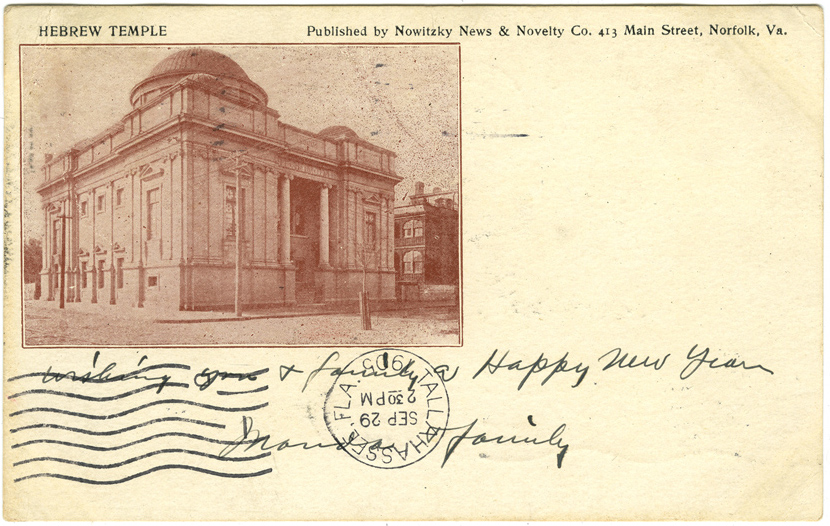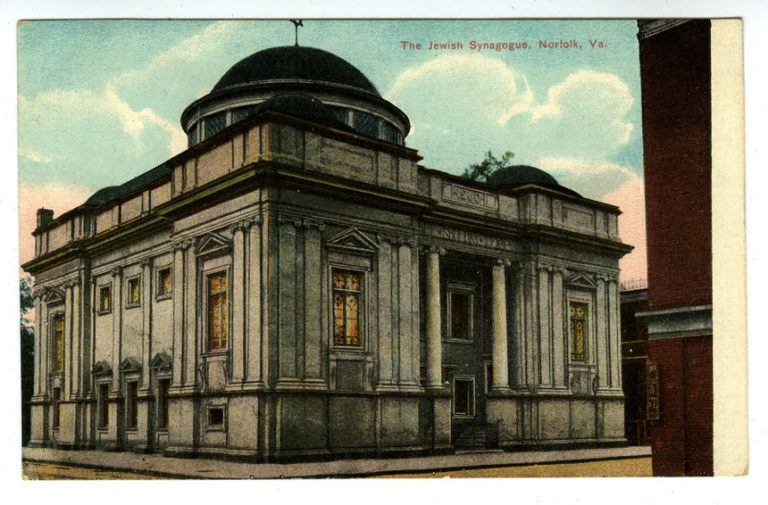6.4 Norfolk, Virginia
Ohef Sholom, Freemason Street and Monticello Avenue
Architect unknown, 1902
Nowitzky News and Novelty Company, Norfolk, Virginia, publisher; no publication date, but postmarked September 29, 1905, in Tallahassee on the front; postmarked September 27, 1905, in Norfolk on the back
This card shows the second home of Ohef Sholom (Lovers of Peace) of Norfolk, Virginia. The Italian Renaissance–style structure served for only 14 years. It was destroyed by fire in 1916, but the congregation was not overly distraught. The Torah scrolls were saved, and the destruction solved the problem of growing frustration with the building’s noisy downtown location. A grander temple—still in use—was built in the Ghent neighborhood of the city.
When dedicated in 1902, the new temple was celebrated by the congregation and in the local press. It was a big change from the former church that Ohef Sholom had occupied for more than 20 years. It was in the newest style: a mix of classical and Renaissance forms and architectural elements. A square plan allowed an ample dome over the sanctuary and smaller decorative domes on the corners. The building was extolled in the Virginia Pilot:
The new edifice complete is one of the most beautiful church buildings in the South. The edifice is about 80 feet square, and in architectural design is of the Italian renaissance type. The structure is two stories in height and is constructed of light pressed brick, with terracotta and limestone trimming, and has a handsome front on Freemason Street. The building is surmounted with five copper-covered domes—one main and four subordinate. The main dome is 40 feet in diameter, giving a splendid exterior and interior effect. The site and synagogue, with furnishings complete, cost between $65,000 and $70,000. 1
The congregation that became Ohef Sholom was started in the 1840s by German immigrants, led by Jacob Umstadter from Hesse. In 1848, the group acquired a Torah from Baltimore and established Congregation House of Jacob, which in its first years met in rented rooms, then on the first floor of the Odd Fellows Hall. When that building burned in 1859, the congregation purchased a lot on Cumberland Avenue and erected Norfolk’s first purpose-built synagogue. In 1867, the congregation was reorganized and renamed Ohef Sholom.
The building was an eclectic structure, marked by two stairways that led to a Greek–style columnar portico on the second floor, through which one passed into the sanctuary. Between the stairs was an entry to the ground level, which would have housed classrooms. At the corners of the building were two slender applied piers that rose all the way to the low gable roofline. These were topped with rectangular caps surmounted by little turrets that rose above the roof, suggesting tiny towers. These were probably the first of many corner tower–like elements to appear on synagogues across the South during the next five decades.

Ohef Sholom was originally an Orthodox congregation. In 1869, however, a ritual reform committee was established, leading to intense and vindictive battles in the congregation. The move to Reform wasn’t as radical as in many cities, but in 1870, an organ was added, and by 1871, the requirement that officers be Sabbath–observant was eliminated. Founder (and hazzan, or reader) Umstadter and his traditionalist supporters left the congregation and established Congregation Beth El (House of God) in 1870. Factional animosity in the community lasted years—and caused a duplication of Jewish institutions. Even so, Ohef Sholom did not join the Union of American Hebrew Congregations until 1907.
Ohef Sholom swapped its 1860 building with a Methodist Church in 1878, and the church was rededicated as a synagogue. Two years later, however, Beth El was able to repurchase the original Ohef Sholom building, reoccupying this structure as an Orthodox congregation until 1920. When Ohef Sholom tired of their former church building, they erected the imposing new synagogue shown here.
1 Virginian Pilot, May 23, 1902, quoted in Irwin M. Berent, Norfolk, Virginia: A Jewish History of the 20th Century (JewishHistory USA Publishers, 2001), 11.

